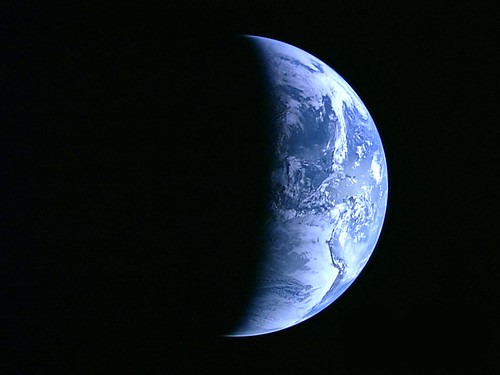The Earth in HD

In September, we discussed the launch Japan’s lunar study, KAGUYA – what many consider the most sophisticated lunar exploration mission in the post-Apollo Era. KAGUYA is already showing results, bringing us the first high definition image of Earth (link):
The photograph was taken from a distance of 110,000 km– hundreds of times further away from Earth than any spaceship with similar capabilities had ever been. After taking these breathtaking images, KAGUYA went on to orbit the Moon and then released a baby satellite as part of its ongoing lunar exploration mission.
Until recently there were only three possible ways to photograph Earth from a distance of several hundred kilometers- via a Space Shuttle, via the International Space Station (ISS) or via orbiting satellites. Now, thanks to the KAGUYA Lunar explorer, which was launched by the Japan Aerospace Exploration Agency (JAXA) and the Japan Broadcasting Corporation (NHK), we can see Earth in its full glory, as it is from afar.
In September 2007, JAXA launched the KAGUYA (SELENA: Selenological and Engineering Explorer) into space. It is composed of a main orbiting satellite and two smaller satellites in polar orbit, and is equipped with instruments for scientific investigation of the Moon.
KAGUYA’s (SELENA) main mission is to collect scientific data from the Moon that will be used to explore the possibility of utilizing the Moon in the future. The three HD CCD 2.2 Mega-pixel cameras onboard the KAGUYA were developed by Japan’s Broadcasting Corporation specifically for this mission. In addition to the cameras, the ship is equipped with 13 other scientific instruments which will be used to explore the Moon.
The abovementioned image was processed from a high resolution video that was shot periodically over eight minutes, on September 29th, 2007. When looking at the image, one can see the outlines of the west coast of South America quite distinctively.
And we have hi-def images of the moon, as well:
This is a still image taken out from the first moving image shooting when the KAGUYA flew from the northern area of the Oceanus Procellarum to the centre of the North Pole. As the altitude near the North Pole is high, the angle of the coming sunlight was lower, thus the shade of the crater topography looks long in the image. The moving image was taken at 4:07 AM on 31 October 2007 (JST) by eight-fold speed intermittent shooting (eight minutes is converged to one minute) from the KAGUYA, and the data was received at the JAXA Usuda Deep Space Centre on the same day.
A video of the moon captured by the HDTV camera is available here.

